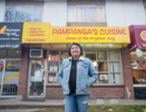Scott Clark, executive director of ALIVE, addresses media in Grandview Park, Nov. 27, 2012. Photo by Katie Hyslop.
The recently discovered suicide pact between mostly Aboriginal students at Britannia Secondary School is just a "symptom" of an "apartheid system" of separate services for urban Aboriginal people in Vancouver, says Scott Clark, coordinator of the Aboriginal Life In Vancouver Enhancement Society.
The pact, involving 30 students from the inner city Vancouver school, was discovered in mid-September but made public earlier this week. Twenty-four of the students, all Aboriginal, were briefly detained by the authorities for their own safety, but have since been released.
Scott Clark, executive director of the Aboriginal Life in Vancouver Enhancement Society (ALIVE) says there has been no coordinated follow up on the well being of these students and their families by government or service organization since.
"There is a total vacuum around the existing 30 children," Clark told the media during a press conference hosted by ALIVE in Grandview Park this morning.
"Everyone has a little information, there is no central location as to how we can follow through on this."
Part of the problem, says Clark, is the existence of separate, Aboriginal-only agencies that provide unequal services for the city's urban Aboriginal population. Unlike land-based treaties, which call for Aboriginal authority and delegation over their own services, Clark says most urban Aboriginal people in Vancouver want to access the same services as everyone else.
"Because this particular community has a large Aboriginal population, you will find Aboriginal people who want to go into the separated services. But if you look at the research, you'll see an awful lot--the majority of Aboriginal people--want the opportunities in the broader community," he said, referring to the Urban Aboriginal Peoples Study and the City's own Dialogues Project, focusing on relations between recent immigrants and urban First Nations people in Vancouver.
Bill Lightbown, former president of United Native Nations and current ALIVE board member, read the media a line from a letter to Clark from Stephanie Cadieux, minister of children and family development, regarding the suicide pact: "I'm very relieved to hear that the suicide pact involving Aboriginal youth was successfully averted."
While this incident may have been avoided, Lightbown made a call to action for he government and service providers before another incident occurs.
"The reality is that the problems are still there and they have to be dealt with, and the governments have to take a much more serious view and attitude towards dealing with these kinds of issues and working with the people in the community," says Lightbown, referring to all levels of government, "especially the parents and the people who are responsible for these children who find themselves unable to cope with the problems that have been created by society as a whole."
In an emailed statement to The Tyee, the Ministry of Children and Family Development (MCFD) outlined several of the actions it has taken since they were alerted to the pact in late September, including working with parents and partner organizations to get families the support they needed and conducting a community intervention session on suicide and self-harm with the families involved.
"The ministry continues to work collaboratively with the (Vancouver Coastal) Health Authority and the community agencies to monitor the situation and ensure the at-risk youth are getting the services they need," reads the statement, adding MCFD also provides funds to the Urban Native Youth Association and Directions Youth Services Centre, which work with at-risk Aboriginal and non-Aboriginal youth in the Strathcona and Grandview-Woodlands neighbourhoods.
"Over 20 thousand children and youth (in British Columbia) receive community mental health services annually – approximately double the number that received services in 2003."
But that's not enough for ALIVE, who want to see a place-based strategy put into action in the inner city immediately.
"There is no one on the community side to support those young people, and this is what we're calling on: an integrated strategy between the doctors, the healthcare professionals, the service organizations, community centres, to develop that strategy so that these young people and their families aren't left hanging once an event as traumatic as this happens," says Clark.
Katie Hyslop reports on education and youth issues for The Tyee Solutions Society. Follow her on Twitter.











What have we missed? What do you think? We want to know. Comment below. Keep in mind:
Do:
Do not: